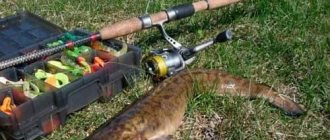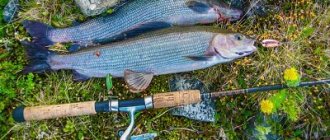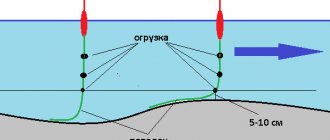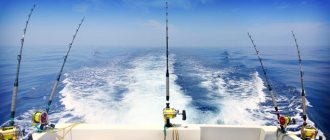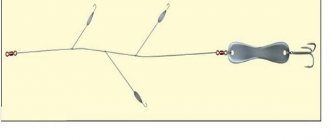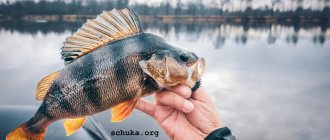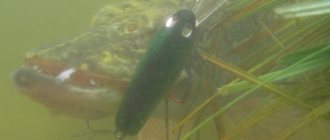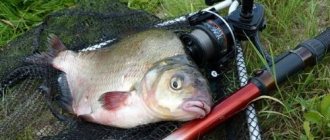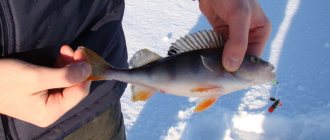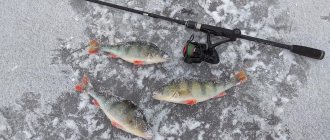Small rivers. No matter how they are called “paddling pool” or “toad pond”, and some even look like small canals, there is something attractive and beautiful about them. For example, I started my journey into the world of spinning with just such a reservoir. I treat small rivers with trepidation. And until now, for many years now, I have not shied away from picking up a spinning rod and going to familiar places. Remember your childhood, tell stories by the fire and just admire nature.
But if you think that everything is so simple here, then you are deeply mistaken, because a small river dictates special requirements for the choice of gear, and in particular for a spinning rod. This is what we will talk about now.
Length
Small rivers are called small because they are small in size, and in some places you can touch the opposite bank with the tip of a fishing rod. Fishing is carried out both “underfoot” and at some distance from the coastline. The width of the river, its depth and the nature of the flow leaves a certain imprint on the choice of fishing rod. I'll explain now. When fishing in the “jabovnik”, you need to use a not very long, but quite powerful spinning rod that can withstand critical loads.
Why is it preferable to use a short spinning rod? It's simple. Firstly, with a short spinning rod it is more convenient to overcome all kinds of thickets and bushes, which, by the way, are present in abundance on such reservoirs. Secondly, with a short spinning rod it is easier to animate a number of baits that require active animation, for example, a wobbler. Well, and thirdly, on small rivers there is simply no need for a long rod, since there is no need for long casting, and all fishing is done, roughly speaking, closely.
For several years now I have been using only classic bass “pegs” on reservoirs of this type. They are quite loud and powerful. I have a length from 190 to 220 centimeters. And believe me, the length of 220 centimeters is enough for your eyes. Throwing the bait 40-50 meters from the shore (although more often such a long cast is not required at all due to the nature of the reservoir) is quite possible. Most often I fish with a GAD Gancho spinning rod with a length of 198 centimeters and a weight of 10.5 to 32 grams. It is powerful, forgiving of many mistakes, and most importantly, wildly versatile, but we’ll talk about that a little later, and now let’s move on to the test border.
Characteristic features of small rivers
The size of the reservoir directly affects the gear used. Small rivers are distinguished by the following features:
- Small width, which means no need for long rods. In such conditions, fishing with a three-meter spinning rod for shore fishing on large rivers is quite inconvenient.
- Relatively smaller food supply, which means slightly smaller catch sizes. Although there is still the possibility of meeting a trophy specimen.
- Small rivers often experience strong fishing pressure, especially if they are located near the city. However, there is also an advantage -
The river can be reached by public transport. The factor of fishermen visiting the reservoir must be taken into account when choosing gear.
- If such a body of water is located in a forest, then you need to be prepared for the fact that the bottom will be almost completely littered with snags. There are also often trees and other obstacles hanging low over the water, which will require exceptional casting accuracy.
- Due to its small size, not only the fisherman has the opportunity (even with the help of polarized glasses) to see the fish, but also vice versa. Consequently, such reservoirs require more attention from the fisherman to their invisibility.
- Such reservoirs warm up much faster and cool down just as quickly, which must be taken into account when planning fishing trips.
Photo 1. The rivers are slow here...
Test
It is the test that determines the power of the spinning rod. In my case it is 10.5-32 grams. To be honest, there is no need to have a spinning rod with such a test. I took a powerful spinning rod just so as not to stand on ceremony with the pike. Gancho plays the role of the uprooter. Thanks to this power, I can easily force fishing in the most “strong” places. This is why powerful spinning rods are required when fishing on a small river. And so for a “toadfisher” it is enough to have a rod with a length of 190 centimeters and a test weight of up to 17-18 grams. Such a test border will allow you to use exactly the range of baits that is so necessary when fishing on a small river. These include wobblers in the size of 80-110 millimeters, unloaded rubber and, of course, a light jig. In addition to Gancho, the ideal shorty for a small river would be Pontoon 21 Resonada with a length of 213 centimeters and a dough from 4 to 18 grams. For me, this is just the perfect rod. It is powerful, very loud, sending and helps to animate the necessary baits. And his type is my favorite – American.
Very often it is necessary to use the “crane” method, since fishing is often carried out from a steep bank, and it is simply impossible to “feed” the bait to the fish in any other way. Therefore, after biting and hooking, we lift the fish on a spinning rod. It’s simply not possible to perform such an action with a flimsy and delicate spinning rod, but Gancho and Resonada cope with a similar task with a bang. Power and the right length are the keys to a good spinning rod for a small river.
Features of postings
Spinning fishing has a wide variety of fishing patterns for each type of bait. The easiest way is with spinners. They are carried out either evenly or with pauses. In the case of other baits, the variety of their animations is quite large. Wobblers, depending on the model, allow both uniform wiring and options with pauses of different durations, as well as a considerable variety of jerking wiring. When fishing with artificial silicone, the following options are often used:
- Classic jig step.
- A step with additional tossing of the bait with the tip of the rod.
- Uniform.
- Dragging along the bottom.
The choice of wiring in each specific case depends not only on the baits used, but also on the activity of the fish. The more reluctant the predator is to bite, the slower the retrieves are needed, and the longer the pauses should be taken.
Important! On small rivers, such an element of equipment as polarized glasses is especially important. Not only do they allow you to spot fish, but they also give you better control over your bait.
Build
This feature, as a rule, distinguishes all spinning rods from each other. I will not talk about what types of systems there are, what they are good for and what they are not. Only essentially, only a small river. And so, for a small river, the most suitable rod would be a spinning rod with a fast action - fast. Why fast? The fact is that spinning rods with such rigidity are as versatile as possible, and this is the most important thing. We can’t take three spinning rods with us fishing at once, no, of course, take them if you want, but I limit myself to one and it’s enough for me. From the point of view of mobility, carrying three or two spinning rods with different directions will be, to put it mildly, stupid.
A spinning rod with a fast action is well suited for fishing with both wobblers and rubber in all its variations. By the way, my favorite Gancho has a fast action, which makes it a real all-rounder.
Fishing techniques on small rivers
Despite the significant difference in the type of bait, I use fairly similar fishing techniques for spinners and small wobblers on a small river. In both cases, the wiring is varied: partly for demolition, but most of it is perpendicular to the shore. In this case, the cast is performed a little higher upstream - usually at a slight angle, and then the bait floats down and at the final stage of the retrieve is already moving against the current. Depending on the “persistence” of the bait, it is carried downward by the current to different distances. For example, small wobblers go almost perpendicular to the shore, and larger spinners return parallel to it. During such “broken” wiring, you have to change the speed of rotation of the reel in order to maintain a constant tension of the braid to control the bait.
In addition, in quiet places where the current slows down and the depth increases, I often cast spinners against the current. This type of drifting helps to deepen the bait well. Only in this case you have to very quickly reel in the slack in the fishing line in order to constantly control the play of the spinner.
You can also fish with sinking wobblers using drift wiring. They also have to be reeled out quite quickly, and due to the game not being as active as spinners, it is not always possible to control the retrieve well. In addition, wiring with the flow is fraught with frequent snags, so I try not to use it in cluttered places. Nevertheless, this fishing technique is one of the main ones when fishing for pike.
I cast downstream quite rarely, although if a promising place is located below you, casting may be justified. Spinner baits cannot be deepened well with such a retrieve, and if they are used, the retrieve should be as slow as possible, with pauses. The same applies to floating wobblers, but here it’s the other way around - slow retrieval is needed not so that the wobbler goes deeper, but so that it floats up. Otherwise, often such baits quickly reach the bottom and begin to “dig” it.
If I fish only from the shore, then I often move downstream of the river, casting for myself. At the same time, the bait passes in front of me, where I move for the next cast. I often move downstream immediately during the retrieve - this way I can prolong the movement of the bait for drift.
When I wade fish, I usually move upstream. The fact is that the turbidity I raise and carry down below can alert the fish. When wading, I often fish with spinners, when I walk approximately in the middle of the river and cast the bait in front of me.
A similar technique of fishing with a spinner and a wobbler is obtained on shallow riffles and reaches. There, both baits are thrown approximately perpendicular to the shore, and then describe an arc. In this case, the fish can be caught at different periods of the retrieve - immediately after casting, attracted by a splash, at different stages of the movement of the bait, jumping out, for example, from under a bush of grass or stone, and, finally, already under the shore, after some It will take time to accompany the bait, and then only decide to bite.
The last type of bite occurs more often in muddy water or when the fish is lethargic. Most often, pike bite this way, often perch, but it can also jump out from under the shore. The chub can also accompany the bait and then pounce on it at its very feet. This is how I caught the only ide so far this season.
Distinctive wiring for wobblers has to be used when catching chub, when this fish rises to the top, and then it is necessary to put the bait with a characteristic splash. I described this situation in the previous section, and it is by no means rare. It happened that more than half of the bites, or even almost all, occurred immediately after casting the bait. Sometimes a pike bites like this, also attracted by the noise of a fallen wobbler.
When a chub prefers to feed from the surface, it can be difficult to tempt it with a spinner. In my memory, only one bighead was caught, which reacted to the splash of a falling spinner and immediately attacked it. In all other cases, he attacked only wobblers, and pecked at turntables during the retrieve. Therefore, if for some reason the chub does not come to the surface, then both types of bait can be equally effective. In addition, in one place that you consider promising, it is useful to change the bait. For example, there were times when, after fishing a point with a spinner, I put a wobbler and quite quickly pulled out a good pike. Probably, she was already attracted by the previous bait, but decided to grab only when this bait was changed. The opposite situations also worked, when the wobbler was changed to a spinner.
I try to fish with a universal spinning rod that works equally well with both types of bait used. Build - medium or medium-fast. Such a soft spinning rod allows you to cast very small baits quite far. Even though we fish on a small river, often a long cast won’t hurt.
The spinning class is light or ultralight, since you rarely have to fish with wobblers heavier than 7 g. My last working tool among the new products this year is Team Salmo Powder. I used this model in both produced versions - 1.9 m long and with a test of 2-8 g, as well as 1.83 m and 1.5-6 g. Both suited my purposes well, and I change them primarily to depending on the baits used.
In general, the gear used on recent fishing trips looks like this. Okuma Helios Gold 25 reel, 0.11 Salmo Elite Braid. Using a thinner cord is fraught with the risk of the bait breaking off when biting, as chub strikes, for example, can be so powerful.
I have quite strict requirements for the reel. Ideal laying of the braid and its automatic transfer to the line roller are the main criteria. I'll explain why. Firstly, when fishing on a small river, you have to stop the cast with your hand so that the bait does not fly over to the other bank, and then a slack is formed that needs to be quickly reeled out.
Secondly, control of the bait should begin immediately after it splashes down. This is necessary both for timely hooking of the chub, which likes to peck at the splash, and in order to quickly give action to the bait carried away by the current. Also, when wiring, the tension of the hole is uneven, and flaws in the winding are possible.
It is possible to use a reel and fishing line on the spool. Due to its stretchability, it will dampen the jerks of the fish. Then there is likely to be a decrease in the number of gatherings, of which, admittedly, there are many. I believe that they happen both because of the softness and “weakness” of the spinning rod - after all, an ultralight rod is not designed for forceful fishing, and because of the small hooks of the baits. First of all, this applies to small wobblers - the size of the tees of rotating spoons is usually enough to hold any fish. Therefore, on the smallest wobblers, I often change the hooks to larger ones.
The issue of using a leash has not yet been completely resolved. At first, focusing mainly on chub and having mostly perch in the by-catch, I successfully managed without a leash. But after the pike cut off the spinner and bit off the tested wobbler “one and a half” right in front of my eyes, I resort to using a leash more and more often.
Now, if there is a high probability of a pike biting, and the predator itself is active and takes a deep bite, I tie a short (about 10 cm) rigid leash made of string or similar material. A swivel is desirable in the upper part, since the spinner will twist a thin braid, and in the lower part there is a small but reliable carabiner. I noticed that the leash does not bother almost any fish if the water in the river is cloudy and the fish itself is active. It can only alert a chub, but only when it is passive and bites while retrieving the bait, and not when it splashes. I successfully caught the largest chub of the season with 0.13 mm braid and a metal leader. Why was the gear so rough? It’s just that before this it was mostly pike that were biting, and there were quite a lot of hooks.
In cases where the water in the river is clear and the probability of catching a pike is small, I still risk not putting a leash. After all, if you remember the number of pike sawed-offs on the small river, then there were few of them, and the pike itself is not such a desirable trophy on the river, it’s just a pity for the bait. In addition, the leash worsens the play of the smallest wobblers, for example Salmo Tiny. This factor must be taken into account when configuring the gear.
Another, in my opinion, very important point in catching perch on small rivers in this way is the correct hooking. Since the bait is in most cases “edible” (and the perch does not always spit out the “inedible” one right away), and its size is rather large, it is necessary to withstand another grandmaster pause so that the fish “chews” this bait. For better tactile control, you should always try to keep the cord as taut as possible in the passive phase of the retrieve. At first, it will not always be clear at what moment of the bite you should hook, but it will not be possible to give universal recommendations here - everything will come with experience.
- Don’t forget to release the fish you catch and don’t listen to the calls of the “right” guys that this is a “fad” and from time immemorial, all our fish were caught exclusively for food. Times have changed, fishing on small rivers with expensive tackle and equipment has become an even more widespread hobby than 50 or 100 years ago, and its main purpose has seriously shifted towards entertainment and meditation. But there are almost no fish left in the reservoirs, and until “catch and release” becomes the rule for most anglers who come to a small river on a day off, it is unlikely to often delight you with exciting bites.
Sensitivity
In view of the fact that fishing, whenever possible, is most often carried out closely and all pike attacks occur before our eyes, such a criterion as sensitivity can be omitted and not be too selective in this regard. But there is a certain peculiarity. Close-up fishing can be done both with unloaded rubber and with wobblers. And whether the form “shocks” or not is a secondary matter. But when we fish with a light jig with a Cheburashka weighing up to 5 grams, sensitivity comes to the fore. We need to have a clear understanding of what is going on at the “other end”. This is where spinning rods with a super fast extra fast action and the most informative tip come into play. By the way, the previously mentioned Resonada series has such a structure, but at the same time it copes well with wobblers and even more so with light jigs, which cannot fail to amaze the fastidious angler.
So if you plan to fish on a small river with a light jig, then be sure to keep in mind that sensitivity in this case comes to the fore. But if you wish, you can find the treasured middle ground.
Tackle for fishing on small rivers
The issue of choosing gear for fishing on a small river is an individual matter; I will not advise or advertise anything, I will simply share, as they say, my own experience. First of all, I only fish with soft silicone baits with a single hook. No doubt, wobblers, jerks, medium and large spoons are fashionable, aesthetically pleasing and very effective, but still, fish in the off-season, all other things being equal, respond more easily to jigs, and I have less and less time for fishing on small rivers so that I can freely experiment. In addition, I exclusively use the “catch and release” method, and any bait with tees in this sense is very traumatic, especially since the fish often grabs them greedily and swallows them deeply.
Since I usually catch pike with a classic jig, and perch with a lead rig, I choose a rod taking into account both requirements. In my case, this is a classic light Japanese “bass” of medium length, moderately delicate and powerful. We must take into account that in recent years I have practically not fished in places where there is an “extreme” snag or there is a need to “throw” the fish onto a one and a half meter cliff. Therefore, I don’t require excess power from the gear and sometimes I even indulge in fishing with an extremely delicate “rockfish” type rod. But this is the exception rather than the rule; it is better to focus on the “bass” - it is definitely more universal. Reel - any suitable size and budget, the main thing is that it fits well with a thin cord (6-8 lb).
Everything is clear with the classic jig, let’s look at the lead rigs. I usually use Carolina or split shot variations. In the first case, a “bullet” weighing 5-7 g acts as a weight, in the second - an ordinary “eared ear” weighing 3-5 g. Sometimes (especially in spring), when the water in the river rises, you have to use slightly heavier weights, but usually The above mentioned scales are enough. I make a leash (for both Carolina and split-shot) from a meter-long piece of fluocarbon with a diameter of 0.18-0.22 mm; for jig I use a regular metal “twist”. I mount the bait without covering the hook tip (as a rule, Owner S-59 size from No. 2 to No. 4). If fishing is carried out in places where it is necessary to often alternate “classic” with a leader rig, then I tie a fastener at the end of the main cord and, if necessary, quickly remove the leash with a classic jig, replacing it with a sinker for a split-shot rig. Perhaps this will seem unaesthetic and clumsy to some, but, on the other hand, it saves a lot of time and nerves, which, when tying thin equipment in the cold with the wind, disappear like water into sand.
Lures for fishing on a small river are perhaps the most interesting question. I’m a fairly ascetic person and I don’t like it when boxes contain several hundred different baits. But, on the other hand, practice has shown that, unfortunately, one or two are not enough. Oddly enough, it is most successful in minimizing the range of baits in the spring. All other things being equal, in 70% of situations I usually have a Manns twister in a color that decent people call “guano-lilac” (and more lumpen layers simply call “sucker”), copied on a classic jig head weighing 3-4 g. Smaller baits arouse increased interest among small fish, and for some reason these twisters work unstable for me on lead rigs. If it happens that the fish is extremely passive, then I switch to the “Carolina”, and if the reservoir is larger, with a well-defined edge, I also use the killer Keitech Swing Impact 3″ on the “Moscow” rig and as bait. For perch weighing 200 grams or more, you don’t need less!
In late autumn and early winter, as I noted above, the fish behavior pattern becomes different (we are talking about small bodies of water, don’t forget). I won’t say that twisters don’t work during this period, but usually they are an order of magnitude less effective compared to other baits, so I don’t exactly exclude them, but relegate them to the background. Of the vibrating tails, the same Swing Impact is still in favor, but increasingly in the size of 2″ rather than 3″. And realistic imitations of crayfish and leeches, presented on leash rigs, are taking the leading positions. For example, over the last season I have been successfully fishing with Keitech Sexy Impact 3.8″ and Jackall Bros. Vector Bug.
The execution of the above simulations can be varied, but the key principle here is smoothly, often even slowly. As a rule, this is a slow drag with pauses of 1.5 - 3 seconds or a step with playing along and with the same delays. The role of the pause in both cases is key, and on days when the perch “closes its mouth” especially categorically, its duration should be increased to 4 or even 5 seconds. Although, admittedly, this makes fishing somewhat boring and monotonous.
Pinwheels and wobblers on a small river
The choice of bait itself matters. I refused to use rubber on small rivers, because it was mainly used to catch pike. The same can be said about oscillating spinners. But with small spinners and wobblers I had to catch a wide variety of fish. Sometimes you don’t even know who will be on the next bite. You can guess this only by the behavior of the fish on the hook, and even then not always. In general, this kind of intrigue is why I love fishing on small rivers. And also for the opportunity to catch those fish that rarely become spinning trophies.
Rotating spoons were the first to add variety to my catches. I often remember one spinning morning on the river, when in a few hours I managed to catch four species of fish, including several roaches. They all took the same bait - a small and light homemade spoon. Having served only one fishing trip, that pinwheel remained at the river bottom. And it was replaced by other, no less interesting baits.
If you look into my box of spinners, you will hardly be able to find any spinners larger than number 3. I leave them for lake fishing. On rivers, my favorite and most suitable tackle is light tackle, which I use for fishing with spinners up to a maximum of 5-6 g. The petal is often wide, like “aglia” - such spinners allow you to carry out fishing in the smallest places and have good control of the game. I also use narrow “longs”, but somewhat less often and in smaller sizes - from 00 to “one”.
Classics of the genre for me are the Osko Aglia and Lucky John MA turntables. In the second number, they are able to catch a wide variety of fish, both in type and size. The discovery of recent seasons was the Pontoon21 spinner, and both models caught well with me: Synchrony and Ball Concept Spinner. Of the interesting fish, I managed to catch a 1.5 kg asp and a chub with the last one.
Spinner Osko Aglia
I would name Osko Aglia No. 2 in copper color as the main catcher of pikes. Perches are often caught on it, but they fade into the background compared to how well toothy predators bite on this spoon. It seems to me that with this bait I get not only the desired model, but also the color - in fairly clear water of small rivers, the copper color is quite universal.
Often they catch good pike not only with the largest spoons from my river set, but also with very small ones. So, I had to pull out fish weighing from a kilogram to two on spinners ranging in size from 00 (two zeros) and weighing up to 3 g. Such spoons are universal because they can catch a wide variety of fish. Moreover, the pike often takes them very skillfully, with the edge of its mouth. At the same time, there is every chance of getting it safely, even if you are fishing without a metal leash.
The list of wobblers that have been successfully caught on the river is longer than that of spinners. I will note only the most striking of them, which surprised us with their catchiness or versatility.
Salmo Tiny is one of the smallest wobblers in my collection. With a length of 3 cm, it weighs 2 g in the floating version and 2.5 g in the sinking version. The main fish that are caught with it are perch and chub. There were also small pike and sometimes bleak with bystryanka. In coastal lulls, in depressions near the vegetation, Tiny will definitely get you a striper. But, of course, the main target when fishing with this wobbler is not perch, but chub. I caught my first chub on the Salmo Tiny and since then I consider this bait one of the most popular for chubs.
For this fish I have two of the most working colors - YT (Yellow Tiger, “yellow tiger”) and BC (Black Cockchafer, “black cockchafer”). Both the floating and sinking versions of “Tini” catch chub - both hold the stream well, showing stable play even in strong currents. The floating Tiny is good when the chub is feeding from the surface, willingly rising for the bait. In this case, bites occur immediately after the bait splashes down, just have time to lower the reel bail and take out the slack. Probably, the “splash” formed when a wobbler falls is similar to the splashdown of a fallen insect, since the chub reacts to it so readily.
Also, when fishing from the surface, the Pontoon21 Mojarrilla 40 FSR wobbler performed well. Having initially chosen it as a chub bait, I first took out a “half-pot” pike, which was quite surprising. This wobbler also produced perch. But it was worth going to the “chub!” a site with a steep and deep opposite shore and a shallow sandy shore nearby, as chubs “strewed” on it. Probably, the weight of 3.5 g was still enough so that when splashing down the bait did not create an excessively noisy splash, but fell naturally. As a result, we managed to catch the largest chub of this season using the Pontoon21 Mojarrilla wobbler. Interestingly, its bite was somewhat different from the attacks of other, smaller relatives. After splashing down the bait, the fish slowly rose to the surface, giving me the opportunity to prepare for hooking, and swallowed the bait almost without impact.
After light wobblers, it’s worth mentioning baits that are heavier and bulkier. Among the new products this season, I would like to highlight Tiny Jack and Gutsy Jack from Lucky John. They have approximately the same wiring horizon - about half a meter, but the game is different in nature. The more active Tiny Jack, despite its volume, has so far brought mainly bites from chubs. But Gutsy Jack can be called a universal bait. After just a few fishing trips, the list of fish caught with it is already quite large.
First of all, this is a good pike by the standards of a small river - up to 2 kg, and perch is also often tempted by it, as an exception, a bleak was caught on the hook, and my friend caught a gudgeon! Of the “white” predators, I caught chub and ide.
Underwater rocks
It seems that everything is fine, and we have decided on the length, action and test, you can take a spinning rod and go to the river, but no. It is important to know one more interesting point. Well, who knows. Be at least familiar with it.
Since on a small river it is preferable to fish with “pegs”, you will encounter some difficulties regarding fishing.
Now I will try to interpret everything in detail. To the extent that a spinning rod with a fast action is very rigid and this is its charm, it also has a downside. An excessively stiff rod helps speed up the landing, but “drains” the fish. There are, as it were, two ways: either you give up comfortable fishing and take a spinning rod with a “live” form, or you are ready to sacrifice gatherings. On a small river, bites occur quite often “under your feet”; the pike literally tears its lip due to an intractable form.
That's the downside to bass pegs, but fortunately there is one option that will help you find that sweet spot. And this golden mean lies in one attractive series of the company Pontoon 21. TAYA spinning rod model TYS732M-T with a length of 220 centimeters and a dough weight from 4.5 to 17.5 grams. Truly a masterpiece and an ideal instrument for a small river. What is ideal and how does this rod differ from others, you ask. And I will answer that everyone. The action is fast, but this rod is more flexible and, if desired, can be bent all the way to the butt. The fish “sticks” to it and there are practically no escapes, of course, unless you deliberately pull the bait out of the predator’s mouth. At the same time, TAYA copes well with all baits within its test. It is not flimsy and moderately powerful, the form is clear, the tip is informative - a real all-rounder! There is no other way to say it.
And so, coming to the logical conclusion of the article, I would like to say once again about the best fishing rods for small rivers. This:
How the speed of bait movement affects fishing performance
Now about the wiring speed. Which wiring is better: continuous or intermittent? Here the choice should directly depend on the activity of the intended production.
If there is a need to fish as large an area of a reservoir as possible in a relatively short time, then the wiring should be uniform.
Uneven wiring for classic spinners does not represent a complete stop of movement, but a slowdown or acceleration of the speed of movement of the bait.
The greatest skill is retrieving the blade, when we stop the movement of a slowly moving spoon, forcing it to practically stand still, and then “wind it up” again.
Thus, you can tempt the laziest and well-fed perch to bite. However, this method will require a very high-quality rod made of high-modulus graphite and a reliable reel.
This is necessary in order to feel the very moment of the petal being torn off and the spinner being inserted. Of course, this method of wiring is the slowest possible, so it can only be used when there is no bite and in a place where the presence of fish is guaranteed.
In the case when the river perch follows the bait, but does not attack it, you can try to move the spoon at normal speed, making a sharp jerk with the tip of the rod every few turns of the reel. This may provoke a predator.
But still, the best thing would be not to select your own wiring option for each specific bait, but to replace the bait itself, and not even one spinner with another, but instead of a spinner, use, for example, a spinner or colored silicone.
Usually, if you are not going to change the bait, only retrieving the blade can radically change the fishing performance.
Fishing spots and fishing tactics
Finding promising fishing spots on a small river is quite easy. First of all this:
- Turns in the river bed. As a rule, in such places pits are formed, near which ambushes of predators are often found.
- Places with reverse flow.
- Placing the bait along a wall of reeds or water lilies can also be effective (pike are most often caught in such places).
- Chub are often found on the rifts.
Important! On small rivers it is much easier for fish to notice a person on the shore. You should be careful about your invisibility - this applies to both the color of your clothes and the noise produced.
Knowing the patterns of the location of catching places on small rivers, it is quite possible to plan a fishing route without leaving home - topographic and satellite maps will help with this.
Source: fishelovka.com

